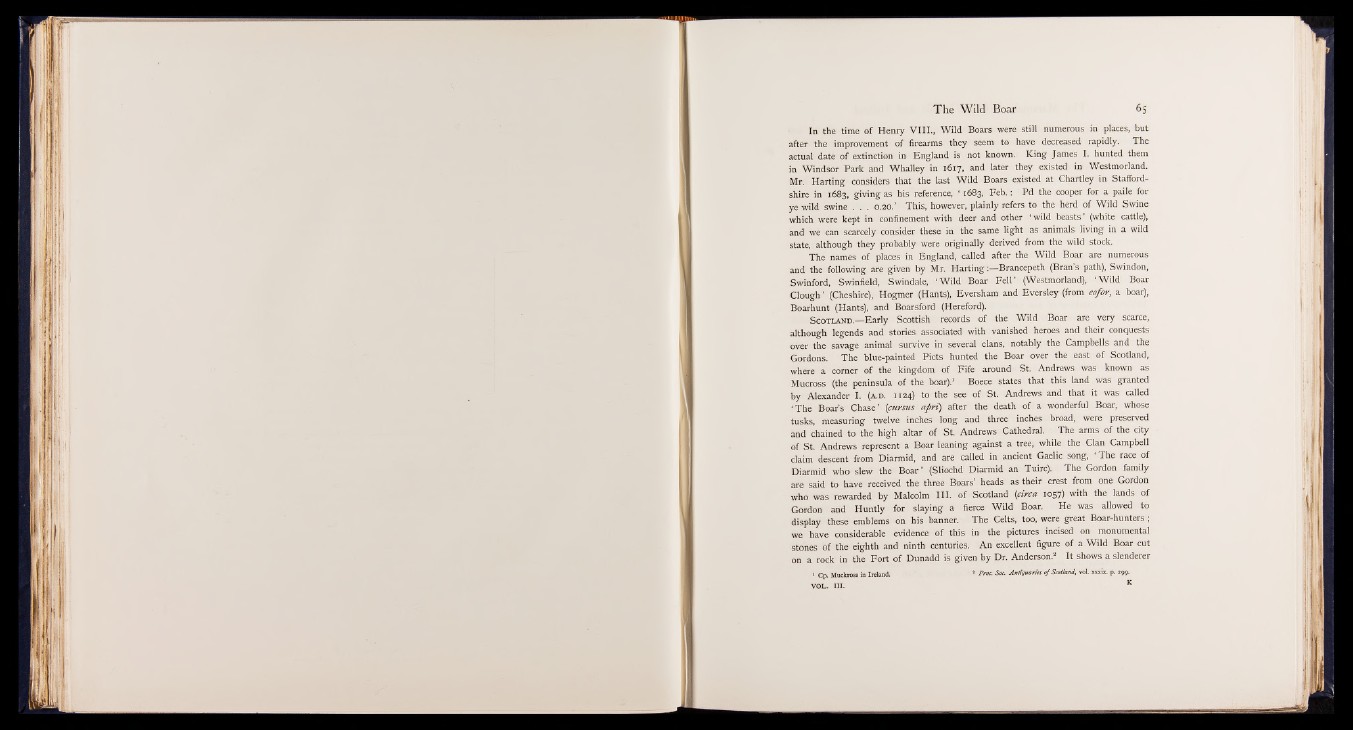
The Wild Boar 65
In the time of Henry VIII., Wild Boars were still numerous in places, but
after the improvement of firearms they seem to have decreased rapidly. The
actual date of extinction in England is not known. King James I. hunted them
in Windsor Park and Whalley in 1617, and later they existed in Westmorland.
Mr. Harting considers that the last Wild Boars existed at Chartley in Staffordshire
in 1683, giving as his reference, ‘ 1683, F eb.: Pd the cooper for a paile for
ye wild swine . . . 0.20.' This, however, plainly refers to the herd of Wild Swine
which were kept in confinement with deer and other ‘ wild beasts (white cattle),
and we can scarcely consider these in the same light as animals living in a wild
state, although they probably were originally derived from the wild stock.
The names of places in England, called after the Wild Boar are numerous
and the following are given by Mr. H artingB rancep eth (Bran’s path), Swindon,
Swinford, Swinfield, Swindale, ‘Wild Boar F e ll’ (Westmorland), ‘Wild Boar
Clough ’ (Cheshire), Hogmer (Hants), Eversham and Eversley (from eofor, a boar),
Boarhunt (Hants), and Boarsford (Hereford).
S c o t l a n d .— Early Scottish records of the Wild Boar are very scarce,
although legends and stories associated with vanished heroes and their conquests
over the savage animal survive in several clans, notably the Campbells and the
Gordons. The blue-painted Piets hunted the Boar over the east of Scotland,
where a corner of the kingdom of Fife around St. Andrews was known as
Mucross (the peninsula of the boar).1 Boece states that this land was granted
by Alexander I. (a.d. 1124) to the see of St. Andrews and that it was called
‘ The Boar’s Chase’ (cursus apri) after the death of a wonderful Boar, whose
tusks, measuring twelve inches long and three inches broad, were preserved
and chained to the high altar of St. Andrews Cathedral. The arms of the city
of St. Andrews represent a Boar leaning against a tree, while the Clan Campbell
claim descent from Diarmid, and are called in ancient Gaelic song, The race of
Diarmid who slew the Boar’ (Sliochd Diarmid an Tuirc). The Gordon family
are said to have received the three Boars’ heads as their crest from one Gordon
who was rewarded by Malcolm III. of Scotland [circa 1057) with the lands of
Gordon and Huntly for slaying a fierce Wild Boar. He was allowed to
display these emblems on his banner. The Celts, too, were great Boar-hunters ;
we have considerable evidence of this in the pictures incised on monumental
stones of the eighth and ninth centuries. An excellent figure of a Wild Boar cut
on a rock in the Fort of Dunadd is given by Dr. Anderson.1 It shows a slenderer
I Cp. Muclcross in Ireland. ’ A w . S x . A nlifuariei o f Suitand, vol. xxji*. p. app.
VOL. III. K